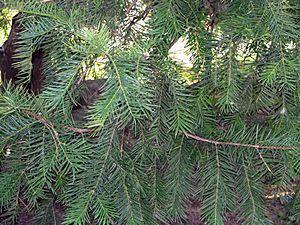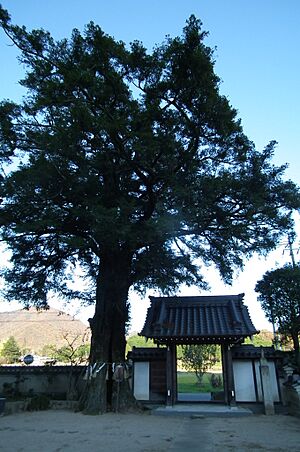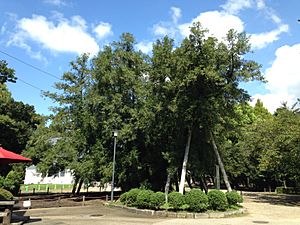Japanese Torreya facts for kids
Quick facts for kids Japanese Torreya |
|
|---|---|
 |
|
| Torreya nucifera foliage | |
| Conservation status | |
| Scientific classification | |
| Genus: |
Torreya
|
| Species: |
nucifera
|
The Japanese Torreya (scientific name: Torreya nucifera) is a special type of coniferous tree. It grows slowly and can be found in southern Japan and on South Korea's Jeju Island. People also call it kaya (which means 榧 in Japanese) or the Japanese nutmeg-yew.
About the Japanese Torreya

This tree can grow quite tall, reaching 15 to 25 meters (about 50 to 80 feet). Its trunk can be as wide as 1.5 meters (about 5 feet). The leaves are always green, like needles, and are about 2 to 3 centimeters long. They have a sharp tip and two white lines underneath.
The leaves are arranged in a spiral around the branch. However, they twist at their base to lie flat on either side of the stem. This tree usually has mostly male or mostly female cones, but sometimes it has a few of the other kind too. Male cones are small and round, about 5 to 6 millimeters wide. They grow in two rows under a shoot. Female cones grow in groups of three to eight. They take about 18 to 20 months to grow into a single seed. This seed is covered by a fleshy layer and is about 2 centimeters long.
What is it Used For?
The wood from the Japanese Torreya tree is very special. It is highly valued for making Go boards and Shogi boards. People love its beautiful yellow-gold color and its smooth, even texture. The wood also makes a nice sound when a game piece is placed on it.
Because of its popularity, the tree was cut down a lot in the past. Now, it is a protected tree in Japan. Very old kaya trees must die naturally before their wood can be used for thick Go boards. This makes these boards extremely expensive, sometimes costing over $19,000!
Since real kaya wood is rare, people sometimes use "Shin-kaya" (meaning "new kaya"). This is usually white spruce from places like Alaska or Siberia. It is a cheaper option for game boards. Sometimes, Go bowls are also made from kaya wood, but this is less common.
The seeds of the Japanese Torreya are safe to eat. People also press them to get vegetable oil. In some special Japanese Buddhist practices, the leaves and oil from the tree are used in rituals. For example, the oil might be burned in a lamp during long meditation.
These trees can also be important to local communities. They often have cultural and historical meaning, like the Japanese Torreya of Samin-ri.
Famous Japanese Torreya Trees
There is a very old Japanese Torreya tree near the Nishinomaru-enokida Gate at Nagoya Castle. This tree is 16 meters (about 52 feet) tall and 8 meters (about 26 feet) wide at its base. It is over 600 years old! This tree was already growing when the castle was built. It is the only natural monument in Nagoya that the government protects.
Even though it was damaged during air raids in 1945, the tree managed to grow back strong. It is said that Tokugawa Yoshinao, the first lord of the castle, used to decorate his dinner tray with nuts from this very tree. He did this before battles and for New Year's celebrations.
See also
 In Spanish: Torreya nucifera para niños
In Spanish: Torreya nucifera para niños



